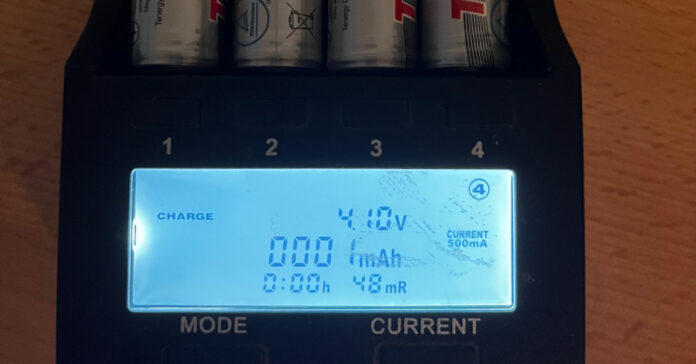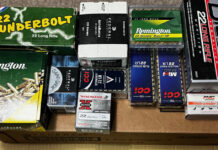
My wife lured me into making a shopping trip with her by promising me breakfast at one of our favorite restaurants. I generally feel guilty about eating breakfast out when we have fresh-from-the-chicken eggs at home, but I didn’t put up much of a struggle since the general store is full of stuff preppers need and want. I mean, how could I say no?
The first general store we went to is the one where we buy our chicken feed and bags of dirt, so while I saw to that, she shopped the clothing and food aisles. Then we moved on to another general store in an adjacent community where they sell lots of work clothes, boots, hunting supplies, guns, and ammo. This is one of my favorite stores and a great place for preppers, or your average rural resident who expects to get snowed in occasionally.
As you might imagine, I have to use cautionl here because they have so many items I want to buy. For a country store in the middle of nowhere, they have an impressive selection of guns and optics, including Holosun red dots and Vortex scopes. I also admired a Benchmade fix-bladed knife that was only $130. They had a .357 lever gun from Rossi for under $700. It looked like a sweet gun, small, light, and easy to handle. I don’t need a lever gun, but it called to me none-the-less. Sadly, I left it on the shelf.
It was a struggle, but I managed to leave without buying any guns or knives. My wife actually spent more money than I did.
Big Boxes of Gun Parts
I have a number of cardboard boxes that hold “gun stuff.” Sometimes, I sort the boxes by platform. For example, I have boxes of AR-15 parts and pieces, from lower parts kits to bolt carrier groups. In some cases, the parts are new. In other cases, I removed a part from a gun and replaced it with something better, but I held onto the old part. I also have boxes slings and holsters because I am rarely satisfied with the first holster I buy for a gun, so I end up with extras.
Last weekend, I pulled several boxes off the shelf and dug through them, looking for a way to add a QR sling to a carbine. I ended up swapping out the entire buttstock. This worked out well, because the “new” buttstock seems sturdier. Who knows where the new one came from or how long I have had it I that box-o-stuff? But it came in handy, and the old buttstock replaced it in the box, just in case I need it one day in the future.
I’ve written in the past about my quest to give every rifle or carbine a sling, an optic, and, where possible, back up iron sights. I have reached the point where I have enough equipment to accomplish this, but it may require some swapping of gear between guns. For example, if I have a 1-8x LPVO scope, would it be better to just add it to a 16-in AR that has no optic, or to remove the ACOG from the 20-inch rifle and put the LPVO on it? I can then put the ACOG on the carbine. That’s what I decided to do, but it takes time and then I have to zero two guns instead of just one.
Recharging Batteries
Sighting in a gun is not a chore so much as an excuse to do some shooting. Sadly, not every prepper chore is as fun. For example, I spent two days swapping batteries in and out of the charger. Topping them off is a task I do every year before hurricane season gets bad.
If you haven’t seen the video I posted on the coming hurricane season, I suggest you take a look. If not, then you should know that Colorado State University and a couple other forecasters think this will be an above-average hurricane season because of the hot water in the Atlantic. Hot water feeds hurricanes, and we could see category 4 or even 5 hurricanes make landfall.
If you live in an area where hurricanes might strike, the time to buy plywood, generators, bottled water and to fill your fuel tanks is well before the hurricanes make landfall. Now would be a good time to check your supplies and restock anything you’ve used up.
We are far enough in land that we don’t have to deal with most of the effects, but they can spin off thunderstorms with high winds and lots of rain that reach us. As a result, I recharged 28 18650 batteries on day one and another 20 the next day. The challenge isn’t charging the batteries, it’s finding them. I have a stash in my gun safe and a stash in a Faraday cage, with a few flashlights and some other small electronics. But I also have batteries in headlamps, flashlights and other devices all over the house, in various bugout bags, and even in my car. My annual pre-hurricane recharging is a good excuse to check on all these devices, ensure they are still in working condition, and check on their batteries.
Battery Performance
It’s always interesting to see how much a specific brand of batter has discharged. All of them had a charge of 4.19 or 4.20 volts last September. Some of them were in excellent shape, holding between 4.08 and 4.12 volts. These recharged the quickest. The worst were around 3.86 volts and took longer to charge.
The best performing were batteries with no over-charge protection or other chip inside. These are industrial 18650s that I salvaged from electronic equipment. The Tenergy batteries have the chip inside, but were all in the 4.05-4.12 range, so the chip is not using too much overhead. Some of the other brands lose power a little more quickly when stored, and I can only assume there is a tiny load put on them by their BMS chip. Yes, those chips are there for our protection, but there is a slight cost which I pay by recharging them at least once per year.
I’ve written previously about the value of rechargeable lithium batteries like the 18650 and their value in a grid-down scenario. If you want to avoid living in the dark ages after the grid goes down, having rechargeable flashlights, headlamps, lanterns, and a basic solar recharging infrastructure is a necessity.
Be a Well-Rounded Prepper
Food, water and shelter may be the big three when it comes to prepping, but let’s not forget that you also need what I call the next three: self-defense, medical/first aid, and communications. Beyond that are many other things, including work clothes, durable footwear, work gloves, batteries, flashlights and lanterns, traps, wire for snares, ammunition, motor oil and other lubricants, livestock feed, firewood and other fuel, the list goes on.
Start with the big three because you don’t want to die from exposure, hunger, or a lack of water, but go beyond these basics. Look at what you use or think you will need to sustain your life, and stock up on those items. Consider what will make your life after the collapse easier and more productive, and make sure you have it on hand. It could be something as simple as 200 feet of drip line for your watering system or it could be as complex as an inverter for a solar power system. Chances are, it is many things. Make a list, set your priorities, and work the list when you have the time, energy, and money.







